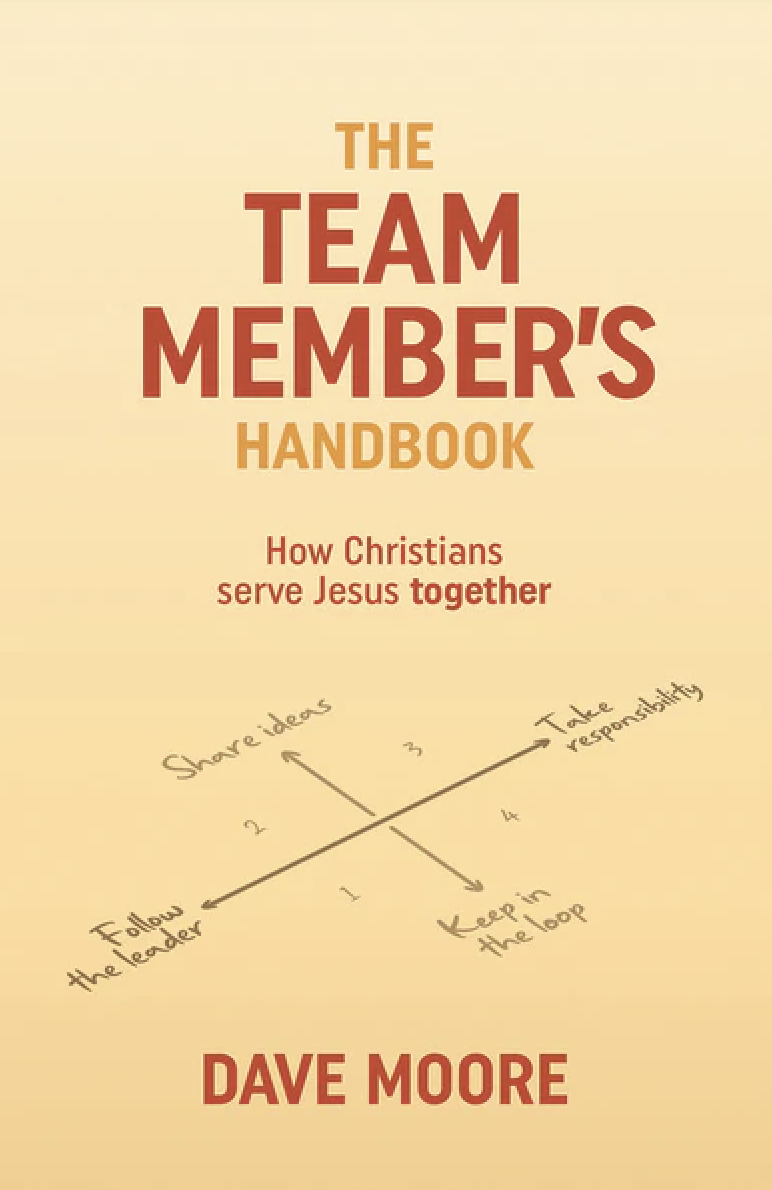The Team Member’s Handbook: How Christians serve Jesus together is the second book by Dave Moore on the topic of team ministry. His first, The Team Leader’s Handbook, was released in 2024. Team Members is a step-by-step handbook for being a great member of a team at church.
Four principles, one team
The book has four parts which move progressively from the big picture to the details. Part one outlines the self-sacrificial service of Jesus in the gospel and the shape that the gospel gives to our service. Part two, serve the big team, helps the reader think about how their service fits into the big picture of Jesus’ mission, their local church’s mission, and the purpose of their whole team. Part three focuses on the participation of an individual on the team and what it looks like to be a great team member. Team Members are encouraged to be Christian (which is often less obvious than it should be), turn up, love their leaders, and be collaborative and flexible. Part four, the final section, provides tools such as DISC and the working genius which will help team members work together understanding each other’s differences.

The Team Members Handbook
Dave Moore
Accessible
One of the things I loved is the way Moore takes the principles of leadership pipeline thinking and makes them accessible and concrete for the regular church member. I’ve found Craig Hamilton’s Wisdom in Leadership Developmentexcellent for getting my own head around these ideas. But I haven’t given Hamilton’s book to individuals serving at various layers of leadership at church because Development goes beyond what regular church members require. Moore’s books are written for people serving in church-based team leadership. At our church we’re still building out our leadership pipeline and learning as we go. Moore’s book is just the tool we need to help us.
One of the ideas we’ve grabbed hold of already is ‘the big prayer.’ The big prayer is the “shared hope for what you and your teammates would love God to achieve through you and within your church, for his glory” (p. 45). Getting our teams to articulate their big prayers has helped us as a staff team be clear about what we want God to do through our teams as we serve and depend on him together!
Audience
As I started reading, I immediately thought of all the contexts in which we could use the book. We’re still building healthy teams at our church and there’s lots for all of us to learn. It’s easy to imagine what it would look like for our youth and kids’ teams to learn from this book together. At our church these are teams of mostly young adults, serving in a substantial way for the first time. They serve together week in and week out and so the potential for leadership formation through input such as Team Members is high.
I find it harder to imagine how to use the book with older adults. I can see the value of using it with adults, but it’s harder to work out what that might look like. They’ve often been serving at church for a while and have already developed a bunch of skills. Additionally, many of them have jobs where they use team skills or lead teams. Getting them to give time to read a book about concepts that will mostly be familiar to them feels like a hard ask! But I’m convinced many of them, like me, still have things to learn or be reminded of. I serve as a member of a team (a church staff team) and was helpfully challenged. Am I a great member of our team? Sometimes, not always. I’ve still got things to learn and implement into my practice. While it might take some careful thought to persuade all our teams to read the book, I think it’ll be worthwhile.
Query #1: Not Convinced or Defined…
Two other questions have stuck with me since reading the book. The first is that Moore assumes a team ministry model. I didn’t flinch at that. Our church is well down the road of implementing team-based ministry and we are persuaded of its value. But if you need to be convinced about team-based ministry or are part of a church which isn’t team-based, Moore doesn’t attempt to convince or define the model in this book.
Query #2: Team or Role Recruitment?
The second question I’ve wrestled with is from chapters 4 and 5. Moore makes the case that as a member of the team your commitment is first to the team, and then to your role on the team. He says, “you’re not committing to a particular role on the team; you’re committing to the team” (p. 49). An implication of this is that as you’re recruited, you’d be asked for commitment to the team, before getting clarity about the role you’re being asked to play on the team.
I get what Moore is pitching for and agree with the broad principle: we will serve better together if our commitment is to the team over our own part on it! But I struggled a bit with the strategy he proposes for getting there. He says, “when we join a team with this mindset, it might start with a bit of ambiguity, but it really leads to a much better sense of cooperation and teamwork” (p. 50). On first reading, my heart rate jumped. Some of my reaction is personality. I like clarity! But some of my reaction comes from experience: of committing to something, only to have the goal posts move. Or the experience of finding myself with more responsibility than I have capacity for, or in a role that I’m not equipped for, requiring more energy and effort than I had anticipated. Of being shot down when I’ve asked for clarity about what I’m being asked to do, and what success would look like. It’s clarity which enables me to commit to the team and serve confidently.
To zoom back out, I’m on board with Moore’s big idea here! And really, I’m splitting hairs. But I do wonder whether you can achieve the outcome of commitment to the team over the role, as Moore advocates, while also providing volunteers with clarity about their place within the team.
We plan on reading The Team Member’s Handbook with the all teams at our church. As we do, I’m excited to see teams taking greater ownership of their big prayer and see men and women growing as disciples of Jesus as they serve side by side, making Jesus known.













